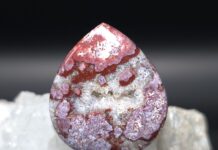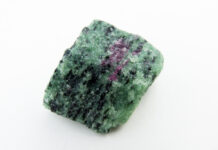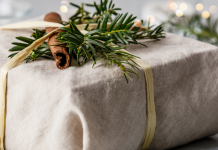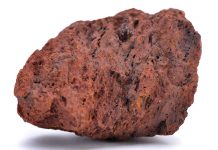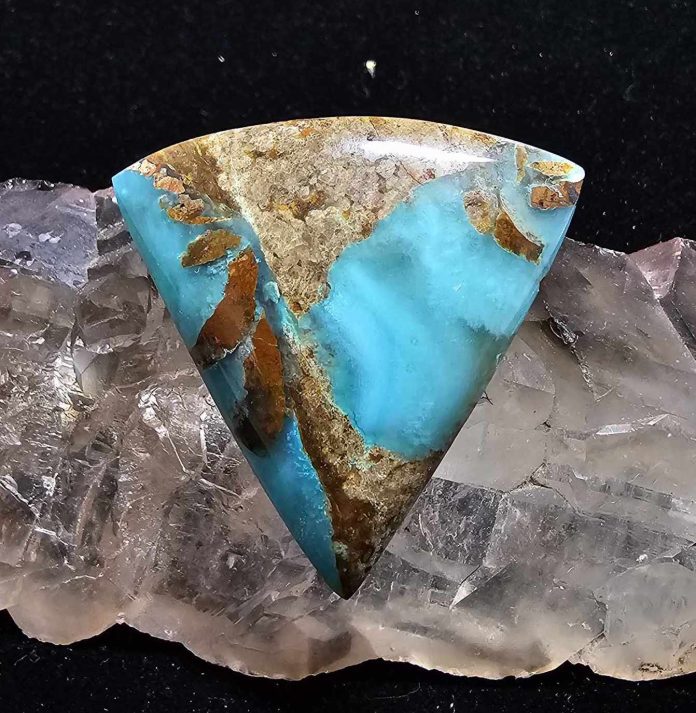
Nevada has always been a popular mining state, mainly for gold and silver, but also well known for its world-renowned turquoise. The Otteson family has several turquoise claims in central Nevada, but miners Ryan Novell and (the late) Rodney Frisby have discovered some of the most beautiful varieties in that area. While out hunting for new deposits, Rodney came across gorgeous seams of gem silica. While there are other similar materials, such as Needles blue agate and Brenda Blue gem silica, this Nevada variation has a great range of colors, ranging from a light sea foam green and baby blue to a deep dark blue. The gem silica runs in veins inside a rhyolitic host matrix, and the two contrast beautifully.
Choosing Quality Gem Silica Rough
There probably isn’t a great deal to be found in the marketplace, but when you find some to buy, look for the largest veins running through the rough. Some of the veins may open up into very large pockets in the center of the stone. Others could work their way down to nothing after a couple of slabs are cut.
Sometimes buying slabs is the way to go, so you know exactly what you are getting. You will pay a bit more of a premium for slabs. If you choose to buy it in the rough, you probably can’t go wrong; the chalcedony veins run pretty heavy in the matrix and should yield several nice cabs.

How to Cut Nevada Gem Silica for Best Results
When cutting the rough, I suggest hand cutting as much as possible because the rhyolite could break by clamping down too hard in the vice. Having it break in a desired spot can be alleviated by manually cutting and going slowly where needed. You never know where it will break apart since the majority of the rhyolite looks heavily fractured to begin with; however, most of it is pretty solid with little to no stabilization needed.
Making a cab from this material is relatively easy, but it does have a few pitfalls. The rhyolitic matrix has a few variances in softness and could undercut slightly.
The chalcedony can easily fracture from excessive friction heat from the wheels, so extra steps are needed in the cabbing process to keep it from fracturing.
Shaping and Refining the Cab
Start shaping your preforms on the 80-grit steel wheel and grind out the dome. Be sure to use a heavy amount of water to keep the stone cool. Lightly smooth the cabs out on a 220-grit steel wheel or a 140-soft resin grit wheel. This should completely shape the cab without any flat spots before moving forward. At this point, move onto the 280-grit soft resin wheel, but be sure to use a lot of water and work the cab in short spurts, drying off occasionally to see if the chalcedony is still showing any scratches. The rhyolite will start to polish at this point since it’s so soft, but the blue areas will need a bit more attention. Just try not to generate too much heat friction from the wheels from sanding too long at one time. Use a dry towel or canned air to dry off the cab and check your progress. As soon as you have all the scratches removed, you can move on to the 600-grit wheel.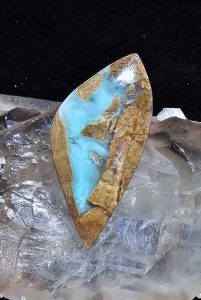
Final Polishing and Care Tips
From this point, it should be routine, much like working any other type of agate, but again, be super cautious of the delicate nature of the chalcedony and not heat the cab too much on any of the polishing wheels. I would suggest giving the cab time to breathe in between stages and allowing it to cool off before moving to the next grit. This will lessen the chances of fractures in the gem silica portions.
Once you’ve reached either 8k or 14k grit, this should be the stopping point; the blue gem silica will have a mirror polish, while the rhyolitic matrix will just be a bit on the glossy side. The contrast in shine makes the blues stand out. After you are finished, leave your cabs in a bowl of water overnight before exposing them to the air. This type of material, much like various other gem-grade chrysocollas, will fracture overnight as it cools off, so be sure to keep it hydrated for several hours.
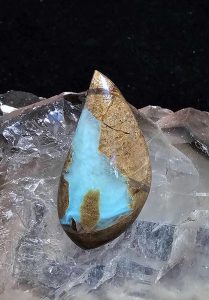
If you choose to add a final polish, cerium oxide on felt works well, but I would suggest using a hand rotary tool with a little Zam polishing compound in short spurts. This will shine up the beautiful blue gem silica and its host matrix.
Nevada gem silica rewards patience. With slow cutting, plenty of water, and careful heat management, the chalcedony shows off a brilliant mirror polish while the rhyolitic matrix provides earthy contrast. Each cab reveals a unique combination of color and texture, making the extra care worthwhile. Take your time, let the stone guide the process, and you’ll finish with a cab that truly highlights this rare Nevada material.
This story about Nevada gem silica previously appeared in Rock & Gem magazine. Click here to subscribe. Story by Russ Kaniuth.



